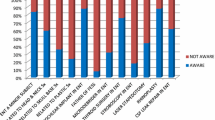Abstract
Specialty choices among medical graduates have undergone changes over time. We aimed to analyze status of otorhinolaryngology as specialty of choice among female medical graduates and factors affecting it. A total of 123 female medical graduates were surveyed during their internship over a period of 1 year in a tertiary-care hospital. Each intern was assessed using a questionnaire at the end of otorhinolaryngology rotation. The survey included nine questions about future career choices with special focus on ENT as a choice for specialization. Questions on choice of specialty, reason for choice, quality of undergraduate teaching and clinical postings were included. The post graduation specialty choices in descending order are Medicine, Pediatrics, Surgery, Obstetrics and Gynecology, Dermatology, Ophthalmology, Radiology, ENT, Anesthesia, Psychiatry followed by Physiology, Anatomy and Biochemistry. Among surgical branches most popular choice was General Surgery followed by Obstetrics and Gynecology, Ophthalmology, ENT and Orthopedics in descending order. Reason for the choice included advice from family and friends. Forty two interns (34.2%) followed advice of senior colleagues, 42 (34.2%) followed advice of relatives in the medical field, 25 (20.3%) took advice of non-medico parents while 14 (11.3%) followed their peer group. Regarding the opinion on the quality of undergraduate teaching and clinical postings, both were rated good by the majority. Otorhinolaryngology is less preferred than other general surgery, Obstetrics and Gynecology and ophthalmology by female medical graduates among surgical disciplines. Possible reasons and ways to improve status of Otorhinolaryngology are discussed.


Similar content being viewed by others
References
Kiker BF, Zeh M (1998) Relative income expectations, expected malpractice premium costs, and other determinants of physician specialty choice. J Health Soc Behav 39:152–167
Dorsey ER, Jarjoura D, Rutecki GW (2003) Influence of controllable lifestyle on recent trends in specialty choice by US medical students. JAMA 290:1173–1178
Dorsey ER, Jarjoura D, Rutecki GW (2005) The influence of controllable lifestyle and sex on the specialty choices of graduating US medical students, 1996–2003. Acad Med 80:791–796
Fysh THS, Thomas G, Ellis H (2007) Who wants to be a surgeon? A study of 300 first year medical students. BMC Med Educ 7:2
Goldacre MJ, Laxton L, Harrison EM, Richards JMJ, Lambert TW, Parks RW (2010) Early career choices and successful career progression in surgery in the UK: prospective cohort studies. BMC Surg 10:32
Ferguson BJ, Grandis JR (2006) Women in otolaryngology: closing the gender gap. Curr Opin Otolaryngol Head Neck Surg 14:159–163
Association of American Medical Colleges (AAMC) Women in U.S. academic medicine: statistics and benchmarking report 2007–2008. Table 2: Distribution of residents by specialty, 1997 compared to 2007
Association of American Medical Colleges (AAMC) Women in U.S. academic medicine: statistics and benchmarking report 2009–2010. Table 2: Distribution of residents by specialty, 1999 compared to 2009
Fletcher MM (1980) A preliminary report on the women otolaryngologist. Am J Otolaryngol 1:211–212
Association of American Medical Colleges (AAMC) 2008 physician specialty data. Table 3: Number and percentage of active physicians by sex and specialty, 2007
Zhuge Y, Kaufman J, Simeone DM, Chen H, Velazquez OC (2011) Is there still a glass ceiling for women in academic surgery? Ann Surg 253:637–643
Davis EC, Risucci DA, Blair PG, Sachdeva AK (2011) Women in surgery residency programs: evolving trends from a national perspective. J Am Coll Surg 212:320–326
Borman KR (2007) Gender issues in surgical training: from minority to mainstream. Am Surg 73:161–165
Kuehn BM (2012) More women choose careers in surgery: bias, work-life issues remain challenges. JAMA 307:1899–1901
Ferrada PA, Anand RJ, Grover A (2011) Virginia Commonwealth University: committed to the professional growth of women in surgery. Am Surg 77:1430–1431
Philips SP, Clarke M (2012) More than an education: the hidden curriculum, professional attitudes and career choice. Med Educ 46:887–893
Grandis JR, Gooding WE, Zamboni BA, Wagener MM, Drenning SD, Miller L, Doyle KJ, Mackinnon SE, Wagner RL (2004) The gender gap in a surgical subspecialty. Arch Otolaryngol Head Neck Surg 130(6):695–702
Eloy JA, Mady LJ, Svider PF, Mauro KM, Kalyoussef E, Setzen M (2014) Otolaryngology regional differences in gender promotion and scholarly productivity. Otolaryngol Head Neck Surgery 150:371–377
Association of American Medical Colleges. 2012 physicianspecialty data book: Center for Workforce Studies. https://members.aamc.org/eweb/upload/2012%20Physician%20Specialty%20Data%20Book.pdf. Accessed Aug 10 2013
Bergeron JL, Wilken R, Miller ME, Shapiro NL, Bhattacharyya N (2012) Measurable progress in female authorship in otolaryngology. Otolaryngol Head Neck Surg 147:40–43
Choi SS, Miller RH (2012) Women otolaryngologist representation in specialty society membership and leadership positions. Laryngoscope 122(11):2428–2433
Author information
Authors and Affiliations
Corresponding author
Ethics declarations
Conflict of interest
The authors declare that they have no conflict of interest.
Ethical Approval
The study was approved by the Institutional Ethical Board.
Informed Consent
Informed consent was obtained from all individual participants included in the study.
Electronic supplementary material
Below is the link to the electronic supplementary material.
Rights and permissions
About this article
Cite this article
Garg, S., Arora, R., Kumar, S. et al. Status of Otorhinolaryngology as Specialty of Choice Among Female Medical Graduates. Indian J Otolaryngol Head Neck Surg 69, 535–539 (2017). https://doi.org/10.1007/s12070-017-1201-7
Received:
Accepted:
Published:
Issue Date:
DOI: https://doi.org/10.1007/s12070-017-1201-7




